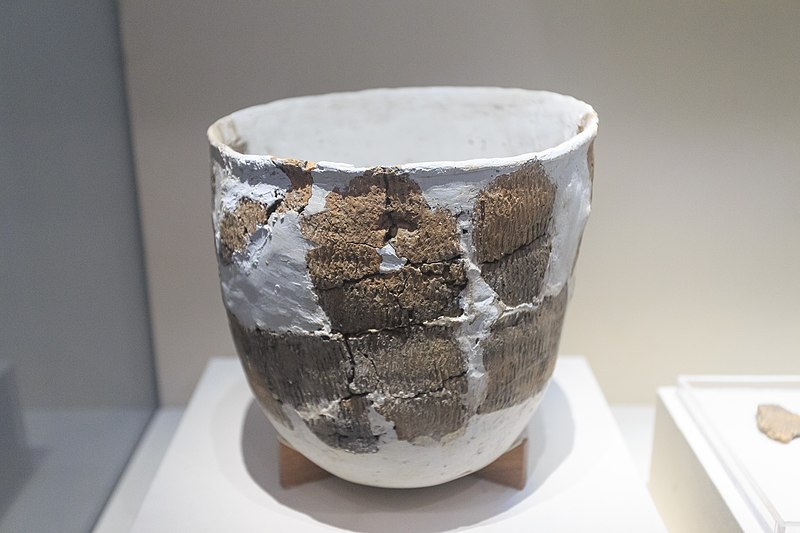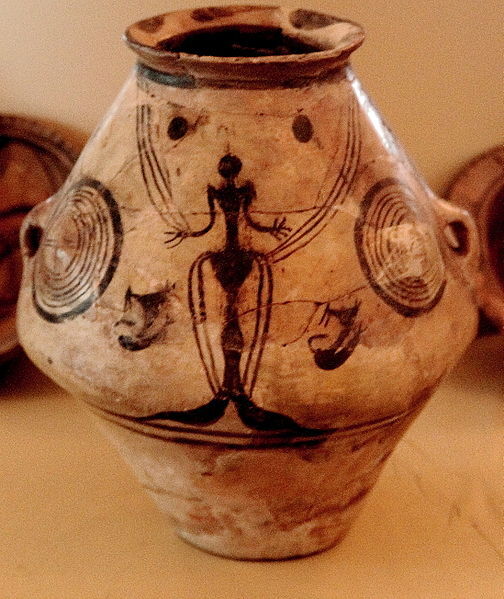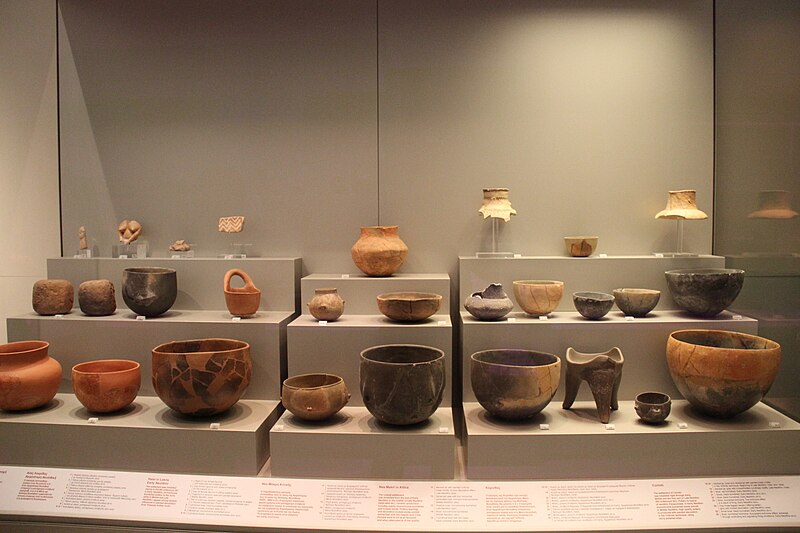Pottery is one of the oldest forms of human craftsmanship, providing a window into ancient cultures and their daily lives. From simple clay vessels to intricate works of art, these early ceramics tell stories of innovation, trade, and survival. The oldest types of pottery ever discovered give us valuable insight into the development of human societies, showcasing the techniques, materials, and designs used by our ancestors. In this article, we’ll explore 15 of the oldest and most significant types of pottery, each offering a glimpse into the past and the creativity of ancient peoples.
Jomon Pottery (Japan)

Jomon pottery, dating back to around 14,000 BCE, is considered the oldest pottery in the world. It was produced by the Jomon people, who lived in prehistoric Japan. The pottery is distinguished by its intricate, cord-marked patterns that were made by pressing ropes into the clay before firing. These pots were primarily used for cooking, storage, and ritual purposes. The techniques of pottery-making during the Jomon period evolved over time, with both hand-coiled and mold-made forms. Remarkably, some of these pots were beautifully decorated, showcasing early Japanese craftsmanship. The longevity of Jomon pottery is a testament to the skill and cultural significance of this ancient civilization.
Xianrendong Pottery (China)

Xianrendong pottery, discovered in the Xianrendong cave in Jiangxi Province, China, dates back to approximately 20,000 BCE. This pottery is among the earliest known examples of ceramics from China. Unlike earlier stone or bone tools, the people of this region created pottery using a simple method of coiling and shaping wet clay. These early vessels were primarily functional, serving as cooking or storage containers. Excavations revealed that the pottery had been carefully fired at relatively low temperatures, indicating the beginning of ceramic technology in East Asia. Some pieces also display signs of decoration, providing a glimpse into early artistic expression. This discovery significantly broadens our understanding of prehistoric life in China.
Cucuteni-Trypillian Pottery (Ukraine and Romania)

The Cucuteni-Trypillian culture, which flourished from 4800 BCE to 3000 BCE in present-day Ukraine and Romania, left behind intricate and well-crafted pottery. These vessels are renowned for their decorative patterns, including spirals, geometric motifs, and stylized representations of animals. The pottery was hand-built and often made using a coiling technique, then smoothed and burnished for a polished finish. Many of the pots served as storage for grains and liquids, essential for the agricultural communities that developed during this period. The size and complexity of the vessels suggest a high degree of social organization and a thriving trade network. Archaeological evidence shows that pottery from this culture was sometimes used in ceremonial and ritual contexts. The artistry of Cucuteni-Trypillian pottery highlights the advanced craftsmanship of these ancient peoples.
Beaker Pottery (Europe)

Beaker pottery, dating to around 2,800 BCE, marks a significant period in prehistoric Europe, especially during the late Neolithic and early Bronze Age. It was characterized by its bell-shaped design and often featured ornate decorations such as vertical lines, hatching, and geometric patterns. Beaker pottery was used primarily for drinking and ceremonial purposes, as evidenced by its association with burial practices. The pottery is most commonly found in burial mounds and tombs, indicating its importance in rituals surrounding death and the afterlife. Beaker pottery spread widely across Europe, from the British Isles to the Danube River basin. Its distribution suggests extensive trade and cultural exchange between different communities. The technological advancement of firing techniques during this period reflects the growing sophistication of European societies.
Yangshao Pottery (China)

The Yangshao culture, which existed from approximately 5000 BCE to 3000 BCE in northern China, produced a distinctive type of pottery known for its fine craftsmanship. Yangshao pottery often featured red and black designs, achieved through the use of slip painting and intricate decoration. The vessels were typically used for cooking and storage, with some being created for ritual purposes. The pottery was made from clay mixed with crushed shells and other materials, enhancing its durability. One of the most notable aspects of Yangshao pottery is the presence of painted motifs, including depictions of animals and abstract symbols. These early pieces reveal the aesthetic sensibilities and artistic traditions of the Yangshao people. Their pottery techniques influenced subsequent ceramic traditions in China.
Indus Valley Pottery (Pakistan and India)

Pottery from the Indus Valley Civilization, dating to around 3300 BCE, is among the earliest evidence of sophisticated urban culture in South Asia. These pots were typically wheel-made, which is indicative of advanced technological knowledge. The pottery was often decorated with geometric patterns and motifs, including images of animals like bulls and elephants. These vessels were used for a wide range of purposes, from cooking to storage and ceremonial use. One of the most fascinating features of Indus Valley pottery is its uniformity and standardization, suggesting a high degree of social organization and trade. Archaeological sites like Mohenjo-Daro and Harappa have revealed entire collections of these pots, many of which were found in residential and public buildings. Indus Valley pottery provides essential clues about the daily life, rituals, and technologies of one of the world’s earliest urban civilizations.
Hopi Pottery (North America)

Hopi pottery, originating around 1200 CE, is one of the most enduring traditions among Native American pottery styles. Known for its bold geometric patterns and symbolic motifs, Hopi pottery is often created using traditional hand-building techniques. The pottery is made from local clay, with designs reflecting the spiritual beliefs and natural surroundings of the Hopi people. Vessels are often painted with elaborate designs that depict animals, plants, and abstract symbols, representing both the natural world and the spirit world. Some Hopi pots are made for practical purposes, while others are crafted specifically for ceremonial use. These pieces are often fired in an open pit, creating a distinctive finish. Hopi pottery is not only a cultural expression but also a significant link to the history and traditions of the Southwest.
Nazca Pottery (Peru)

Nazca pottery, dating from approximately 100 BCE to 800 CE, is recognized for its vibrant colors and detailed motifs. The Nazca people, from southern Peru, created pots that often depicted animals, deities, and scenes from daily life. These vessels were made using a technique called slip painting, which involved applying liquid clay to the surface before firing. The colors used were often derived from mineral-based pigments, producing vivid reds, yellows, and blacks. Many of the Nazca pots served as ceremonial vessels, used in rituals to honor gods and ancestors. Their shapes varied from traditional pots to anthropomorphic figures, reflecting the culture’s connection to the supernatural. Nazca pottery continues to be a key symbol of the rich artistic heritage of ancient Peru.
Minoan Pottery (Crete)

Minoan pottery, which flourished between 2000 BCE and 1450 BCE, is some of the most iconic pottery from the ancient Mediterranean. Created by the Minoan civilization on the island of Crete, it is characterized by vibrant colors, flowing lines, and natural motifs such as marine life and plants. The Minoans utilized a variety of techniques, including the potter’s wheel, to shape their wares, allowing for more consistent and delicate forms. Many Minoan pots were used for both practical and ceremonial purposes, with some adorned with intricate fresco-style paintings. The sophistication of their craftsmanship shows an advanced understanding of materials and artistic techniques. The potteries from the Minoan era reveal much about their trade networks, as similar styles have been found across the Mediterranean. By 1450 BCE, Minoan pottery had reached its peak before the decline of the civilization.
Egyptian Pottery (Egypt)

Egyptian pottery dates back to around 5000 BCE, with early examples made by hand-coiling techniques before the advent of the potter’s wheel. This pottery was primarily used for utilitarian purposes, such as storage and cooking, but some pieces were also intricately decorated. Early Egyptian pots were often plain, but as the civilization evolved, the pottery became more elaborate, featuring bright colors and symbolic motifs. The most famous Egyptian pottery includes large storage jars, often found in tombs and used for preserving food and drink. Finer pieces, such as ceremonial vessels, were beautifully painted and glazed, showcasing detailed depictions of daily life, deities, and royal figures. Egyptian potters achieved impressive advances in kiln technology, enabling them to fire pottery at higher temperatures. Their craftsmanship continued to evolve until the Greco-Roman period.
Mesopotamian Pottery (Iraq)

Pottery from ancient Mesopotamia dates back to around 5000 BCE, with the earliest examples belonging to the Sumerian civilization. Mesopotamian pottery was typically handmade, although the introduction of the potter’s wheel around 3000 BCE revolutionized production. The pottery was often functional, including storage jars, bowls, and cooking vessels, though some items were elaborately decorated for ceremonial purposes. The Sumerians and Akkadians were known for their use of geometric designs and motifs, often inspired by nature and the cosmos. Mesopotamian pottery also played a key role in trade, with distinctive styles found in regions as far as the Indus Valley. Potters also crafted clay tablets for writing, showcasing their versatility in using clay. Over time, the designs became more intricate and symbolically significant, reflecting the region’s spiritual beliefs.
Greek Pottery (Greece)

Greek pottery, which reached its peak around 500 BCE, is renowned for its fine craftsmanship and artistic expression. Early Greek pottery was simple and used for everyday tasks, but it evolved into a medium for artistic storytelling, particularly through the use of black-figure and red-figure painting techniques. These pots often depicted scenes from Greek mythology, daily life, and athletic events, offering a glimpse into ancient Greek culture. The potter’s wheel, which the Greeks perfected, allowed for more uniform shapes and sizes. The most famous forms of Greek pottery include kraters, kylixes, and amphorae, many of which were used to hold liquids or as grave markers. Greek pottery was highly valued throughout the Mediterranean and was traded extensively. The legacy of Greek pottery endures, influencing the pottery traditions of later civilizations.
Etruscan Pottery (Italy)

Etruscan pottery, dating from around 900 BCE, offers valuable insight into the culture of pre-Roman Italy. The Etruscans were skilled potters who created both functional and decorative pottery, using fine clay and often adding intricate details. Their pottery typically featured geometric patterns, as well as depictions of Etruscan gods, funerary rituals, and daily life. The Etruscans are also known for their painted and relief-decorated pottery, which was often used in burial practices. Many pieces were used as grave goods, placed in tombs to accompany the deceased in the afterlife. The Etruscans’ advanced kiln techniques allowed them to produce high-quality pottery, and their work influenced Roman ceramics. By the 3rd century BCE, their distinctive pottery styles began to blend with Roman traditions.
Roman Pottery (Italy)

Roman pottery, which dates back to around 500 BCE, evolved from the earlier Greek traditions, although the Romans developed their own distinct style. Roman pottery was produced in mass quantities, with pieces ranging from simple utilitarian vessels to finely crafted works of art. The introduction of the potter’s wheel allowed Roman potters to produce consistent and uniform pieces. Many Roman pots were used for cooking, storage, and serving, with amphorae being the most famous form for transporting goods like wine and olive oil. The Romans also perfected the technique of terra sigillata, a red-glossed pottery that was highly prized throughout the Roman Empire. Ceramic tiles and bricks, often stamped with the maker’s mark, were used in construction, showcasing the utilitarian nature of Roman pottery. Roman pottery influenced many subsequent cultures, particularly in Europe and the Mediterranean.
Celtic Pottery (Europe)

Celtic pottery, which dates back to around 800 BCE, was known for its hand-built techniques and distinctive, often ornate designs. Celtic potters used simple tools to create functional pieces, such as cooking pots, storage jars, and bowls. Many pots were decorated with geometric patterns and abstract motifs, reflecting the spiritual and symbolic importance of art in Celtic culture. The Celts were also skilled at using the wheel to create smooth, symmetrical forms, although hand-building remained the predominant method for creating large vessels. The use of burnt orange and reddish hues was common in Celtic pottery, with some examples showing detailed carvings and relief work. The pottery served a variety of purposes, from daily household needs to ritualistic offerings. Celtic pottery was widely traded, influencing neighboring cultures across Europe.
This article originally appeared on Rarest.org.
More From Rarest.Org
Bicycles have played a crucial role in shaping transportation throughout history, offering a practical, affordable, and environmentally friendly way to get around. From early designs that barely resembled the bikes we know today, to the more sophisticated models that revolutionized travel, each advancement brought us closer to the bicycles we rely on now. Read more.
The world of MMORPGs has come a long way, but the roots of the genre reach back to some truly pioneering games that shaped online gaming as we know it. From early text-based adventures to groundbreaking 3D worlds, these oldest ones set the stage for the immersive, community-driven experiences players enjoy today. Read more.
Bridges tell the story of America’s engineering heritage, linking landscapes and people across generations. Some of the oldest bridges in the United States offer a glimpse into early craftsmanship, each built with purpose and precision. Read more.



